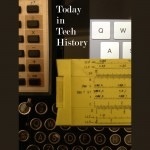
1954 – At 5:30 PM the world’s first nuclear power station was connected to the power grid in Obninsk, US.S.R., a small town 60 miles south of Moscow.
http://www.iaea.org/newscenter/news/2004/obninsk.html
1974 – At 8:01 AM, a supermarket cashier scanned a 10-pack of Wrigley’s chewing gum across a bar-code scanner at Marsh Supermarket in Troy, Ohio. It was the first product ever checked out by Universal Product Code.
http://www.nytimes.com/2009/06/26/technology/26barcode.html
1997 – The US Supreme Court struck down a portion of the Communications Decency Act as violating the first amendment protecting free speech.
http://www.cnn.com/US/9706/26/cda.overturned.hfr/index.html?eref=sitesearch
2014 – Google’s Advanced Technology and Projects lab stole the show at the Google I/O developer conference, with a demonstration of Project Tango’s 3D-mapping capability and Project Ara’s modular phone.
http://mashable.com/2014/06/26/google-project-tango-ara/
Read Tom’s science fiction and other fiction books at Merritt’s Books site.